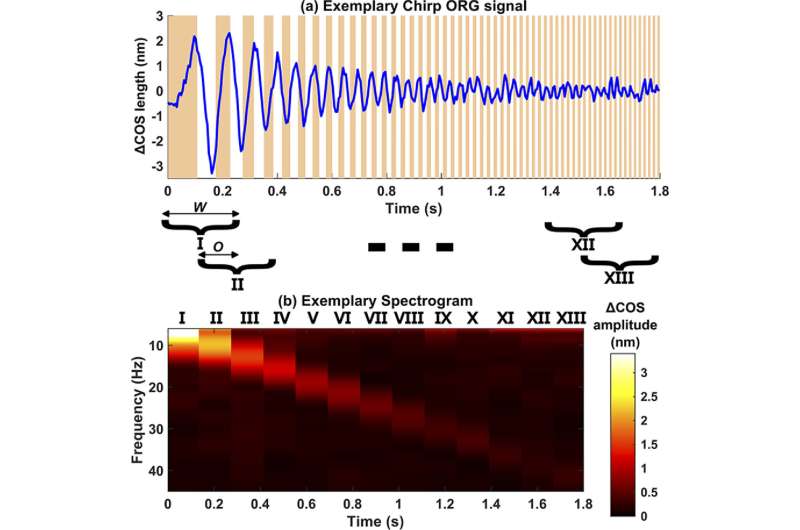This article has been reviewed according to Science X's editorial process and policies. Editors have highlighted the following attributes while ensuring the content's credibility:
fact-checked
peer-reviewed publication
trusted source
proofread
New method allows quick measurement of photoreceptor response

Photoreceptors are the fundamental component of the entire vision process. These specialized cells that absorb light and trigger a specific physiological reaction in the body come in two varieties: cones (responsible for sharp color vision) and rods (responsible for black-and-white vision in low light, e.g. after dark). To properly receive visual stimuli and perceive the world around us, we need both in large quantities.
Flicker electroretinography (f-ERG) is a valuable tool that has been used for decades to study the physiological functions of the retina. Scientists from the International Centre for Translational Eye Research—ICTER, operating within the Institute of Physical Chemistry, Polish Academy of Sciences, have made great progress in developing a technique that is its optical equivalent—flicker optoretinography (f-ORG)—which may be applied in diagnosing certain visual disorders.
A team of scientists consisting of Sławomir Tomczewski, Piotr Węgrzyn, Maciej Wojtkowski and Andrea Curatolo developed a method that allows for quick measurement of the frequency characteristics of photoreceptors' response to flicker stimulation. The work "Chirped flicker optoretinography for in vivo characterization of human photoreceptors' frequency response to light" was published in the journal Optics Letters.
Optoretinography is a step ahead of electroretinography
Many eye diseases have a complex structure-function relationship, and photoreceptor abnormalities often manifest themselves on various levels, including their appearance and operation. The time interval between functional deficits and the perceived pathological changes in the eye is variable and difficult to determine, and in ophthalmological practice, psychophysical methods (e.g. microperimetry, tests of sensitivity to flickering light) and electrophysical methods (e.g. electroretinography) are used.
Electroretinography (ERG) is an objective, slightly invasive method capable of measuring electrical potentials from retinal neurons in response to light stimulation. This technique has proven effective in the early detection of retinitis pigmentosa, X-linked retinal detachment, and diabetic retinopathy.
In recent years, it has been shown that optical coherence tomography (OCT) allows the detection of small changes in the structure of the retina occurring in response to a light stimulus. This was the basis for developing optoretinography (ORG)—the optical and non-invasive equivalent of ERG.
Professor Wojtkowski's team focuses on the use of flickering light to stimulate the retina (f-ORG method). In 2022, in their previous publication on f-ORG, the ICTER team showed that it is possible to perform f-ORG measurements in a large frequency range (up to 50 Hz). In their latest work, the ICTER research team proposed a new approach to f-ORG measurements allowing for quick determination of the frequency characteristics of photoreceptors.
"A flicker protocol with variable instantaneous frequency combined with appropriate light adaptation has two advantages. On the one hand, it enables rapid measurement of the frequency response characteristics of photoreceptors; on the other hand, it also allows you to shorten the time between measurements by avoiding several minutes of adaptation to darkness," says Dr. Tomczewski from ICTER.
Important findings regarding f-ORG
In the standard f-ORG approach, obtaining a full frequency response of the human eye's photoreceptors to flicker requires a large number of measurements at separate stimulus frequencies and time-consuming data processing for each of these sets.
Implementing variable frequency flicker into f-ORG significantly decreases the number of measurements needed to characterize the frequency response of photoreceptors, drastically reducing the time required to conduct experiments and analyze data. ICTER scientists have shown that there are no significant differences between results obtained using this new, fast approach and a separate frequency flicker ORG.
Taking into account the limited number of objects and measurements, the research carried out is preliminary and requires further development. Work is currently underway to explain the mechanism of the phenomenon used in ORG and its relationship with the vision process. Ultimately, the new tool developed at ICTER may deliver a new frequency response-based biomarker for early detection of retinal diseases and therapy monitoring.
More information: Sławomir Tomczewski et al, Chirped flicker optoretinography for in vivo characterization of human photoreceptors' frequency response to light, Optics Letters (2024). DOI: 10.1364/OL.514637




















